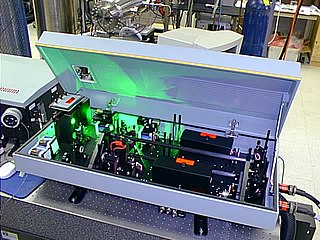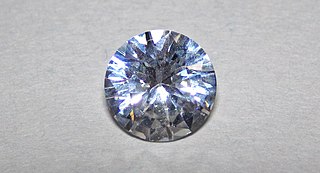
A laser is constructed from three principal parts:

Nonlinear optics (NLO) is the branch of optics that describes the behaviour of light in nonlinear media, that is, media in which the polarization density P responds non-linearly to the electric field E of the light. The non-linearity is typically observed only at very high light intensities (when the electric field of the light is >108 V/m and thus comparable to the atomic electric field of ~1011 V/m) such as those provided by lasers. Above the Schwinger limit, the vacuum itself is expected to become nonlinear. In nonlinear optics, the superposition principle no longer holds.

Nd:YAG (neodymium-doped yttrium aluminum garnet; Nd:Y3Al5O12) is a crystal that is used as a lasing medium for solid-state lasers. The dopant, triply ionized neodymium, Nd(III), typically replaces a small fraction (1%) of the yttrium ions in the host crystal structure of the yttrium aluminum garnet (YAG), since the two ions are of similar size. It is the neodymium ion which provides the lasing activity in the crystal, in the same fashion as red chromium ion in ruby lasers.

Ti:sapphire lasers (also known as Ti:Al2O3 lasers, titanium-sapphire lasers, or Ti:sapphs) are tunable lasers which emit red and near-infrared light in the range from 650 to 1100 nanometers. These lasers are mainly used in scientific research because of their tunability and their ability to generate ultrashort pulses thanks to its broad light emission spectrum. Lasers based on Ti:sapphire were first constructed and invented in June 1982 by Peter Moulton at the MIT Lincoln Laboratory.

In optics, the Pockels effect, or Pockels electro-optic effect, is a directionally-dependent linear variation in the refractive index of an optical medium that occurs in response to the application of an electric field. It is named after the German physicist Friedrich Carl Alwin Pockels, who studied the effect in 1893. The non-linear counterpart, the Kerr effect, causes changes in the refractive index at a rate proportional to the square of the applied electric field. In optical media, the Pockels effect causes changes in birefringence that vary in proportion to the strength of the applied electric field.
A diode-pumped solid-state laser (DPSSL) is a solid-state laser made by pumping a solid gain medium, for example, a ruby or a neodymium-doped YAG crystal, with a laser diode.

Diamond turning is turning using a cutting tool with a diamond tip. It is a process of mechanical machining of precision elements using lathes or derivative machine tools equipped with natural or synthetic diamond-tipped tool bits. The term single-point diamond turning (SPDT) is sometimes applied, although as with other lathe work, the "single-point" label is sometimes only nominal. The process of diamond turning is widely used to manufacture high-quality aspheric optical elements from crystals, metals, acrylic, and other materials. Plastic optics are frequently molded using diamond turned mold inserts. Optical elements produced by the means of diamond turning are used in optical assemblies in telescopes, video projectors, missile guidance systems, lasers, scientific research instruments, and numerous other systems and devices. Most SPDT today is done with computer numerical control (CNC) machine tools. Diamonds also serve in other machining processes, such as milling, grinding, and honing. Diamond turned surfaces have a high specular brightness and require no additional polishing or buffing, unlike other conventionally machined surfaces.

Monopotassium phosphate (MKP) (also, potassium dihydrogen phosphate, KDP, or monobasic potassium phosphate) is the inorganic compound with the formula KH2PO4. Together with dipotassium phosphate (K2HPO4.(H2O)x) it is often used as a fertilizer, food additive, and buffering agent. The salt often cocrystallizes with the dipotassium salt as well as with phosphoric acid.

Yttrium aluminium garnet (YAG, Y3Al5O12) is a synthetic crystalline material of the garnet group. It is a cubic yttrium aluminium oxide phase, with other examples being YAlO3 (YAP) in a hexagonal or an orthorhombic, perovskite-like form, and the monoclinic Y4Al2O9 (YAM).

Potassium titanyl phosphate (KTP) is an inorganic compound with the formula K+[TiO]2+PO3−4. It is a white solid. KTP is an important nonlinear optical material that is commonly used for frequency-doubling diode-pumped solid-state lasers such as Nd:YAG and other neodymium-doped lasers.
This is a list of acronyms and other initialisms used in laser physics and laser applications.
Caesium lithium borate or cesium lithium borate (CsLiB6O10), also known as CLBO, is a non-linear crystal for ultraviolet applications and generates the fourth and fifth harmonics of the Nd:YAG fundamental laser wavelength (1064 nm).
Potassium aluminium borate (K2Al2B2O7) is an ionic compound composed of potassium ions, aluminium ions, and borate ions. Its crystal form exhibits nonlinear optical properties. The ultraviolet beam at 266 nm can be obtained by fourth harmonic generation (FGH) of 1064 nm Nd:YAG laser radiation through a nonlinear crystal K2Al2B2O7 (KABO).
An optical frequency multiplier is a nonlinear optical device in which photons interacting with a nonlinear material are effectively "combined" to form new photons with greater energy, and thus higher frequency. Two types of devices are currently common: frequency doublers, often based on lithium niobate (LN), lithium tantalate (LT), potassium titanyl phosphate (KTP) or lithium triborate (LBO), and frequency triplers typically made of potassium dihydrogen phosphate (KDP). Both are widely used in optical experiments that use lasers as a light source.

Lithium triborate (LiB3O5) or LBO is a non-linear optical crystal. It has a wide transparency range, moderately high nonlinear coupling, high damage threshold and desirable chemical and mechanical properties. This crystal is often used for second harmonic generation (SHG, also known as frequency doubling), for example of Nd:YAG lasers (1064 nm → 532 nm). LBO can be both critically and non-critically phase-matched. In the latter case the crystal has to be heated or cooled depending on the wavelength.

Second-harmonic generation (SHG), also known as frequency doubling, is the lowest-order wave-wave nonlinear interaction that occurs in various systems, including optical, radio, atmospheric, and magnetohydrodynamic systems. As a prototype behavior of waves, SHG is widely used, for example, in doubling laser frequencies. SHG was initially discovered as a nonlinear optical process in which two photons with the same frequency interact with a nonlinear material, are "combined", and generate a new photon with twice the energy of the initial photons, that conserves the coherence of the excitation. It is a special case of sum-frequency generation (2 photons), and more generally of harmonic generation.
Neodymium-doped yttrium lithium fluoride (Nd:YLF) is a lasing medium for arc lamp-pumped and diode-pumped solid-state lasers. The YLF crystal (LiYF4) is naturally birefringent, and commonly used laser transitions occur at 1047 nm and 1053 nm.

Electro-optic rectification (EOR), also referred to as optical rectification, is a non-linear optical process that consists of the generation of a quasi-DC polarization in a non-linear medium at the passage of an intense optical beam. For typical intensities, optical rectification is a second-order phenomenon which is based on the inverse process of the electro-optic effect. It was reported for the first time in 1962, when radiation from a ruby laser was transmitted through potassium dihydrogen phosphate (KDP) and potassium dideuterium phosphate (KDdP) crystals.
Organic materials are expected to have relatively strong nonlinear optical properties due to delocalized electrons at * orbitals. This expectation explains extensive search for better NLO materials among organic crystals.

Lightwave Electronics Corporation was a developer and manufacturer of diode-pumped solid-state lasers, and was a significant contributor to the creation and maturation of this technology. Lightwave Electronics was a technology-focused company, with diverse markets, including science and micromachining. Inventors employed by Lightwave Electronics received 51 US patents, and Lightwave Electronics products were referenced by non-affiliated inventors in 91 US patents.













